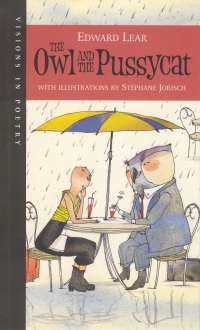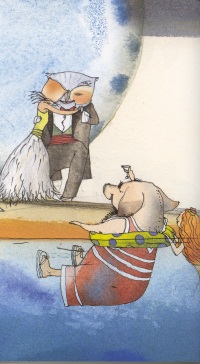| ________________
CM . . .
. Volume XIV Number 6 . . . .November 9, 2007 
 |
The Owl and the Pussycat. (Visions in Poetry).
Edward Lear. Illustrated by Stéphane Jorisch.
Toronto, ON: Kids Can Press, 2007.
48 pp., pbk. & hc., $11.95 (pbk.), $18.95 (hc.).
ISBN 978-1-55453-232-2 (pbk.), ISBN 978-1-55337-828-0 (hc.).
Subject Headings:
Nonsense-verses, English.
Children's poetry, English.
Grades 4-8 / Ages 9-13.
Review by Gregory Bryan.
***½ /4
|
| |
|

excerpt:
So they took it away,
and were married next day
By the turkey
who lives on the hill.
The sixth title in the KCP Poetry "Visions in Poetry" series is Edward Lear's The Owl and the Pussycat—the unusual story of romance between two very different creatures. The Owl and the Pussycat is perhaps the best known of Edward Lear's many poems. Known for his nonsense poetry and for popularizing the limerick form, Lear was also a nature and landscape artist and a travel writer.
Given my delight in the series, I was as eagerly awaiting the new poetry title as I was for the recent final instalment in the Harry Potter series of books. I was very interested to see that the publishers elected to return to the artist who illustrated the first title in the series. Stéphane Jorisch provided the illustrations for Jabberwocky. On the one hand, I was pleased to see a return to such a unique and talented artist, but, on the other hand, I was a little disappointed that another artist was not given the opportunity to interpret a poem for the series. Jorisch, however, has won three Governor General's awards for his illustrations, including the 2004 award for Jabberwocky. It is a fussy critic who finds something to complain about with his employment.
The colourful illustrations were rendered in pencil, ink, watercolour and Adobe Photoshop. The artwork was influenced by Lear's own illustrations and the work of Spanish artist, Joan Miró. Although it goes unacknowledged, there is also an unmistakable nod toward the redoubtable M. C. Escher.
 Jorisch has portrayed the owl as a wealthy inhabitant of Owl Heights—an exotic looking location reminiscent of Venice. The owl has a maid and an extensive art collection. The pussycat comes from the other side of the tracks. With her heavy boots, orange leggings and form-fittings clothes, she makes an interesting contrast to the heavy-set, suit-wearing owl. The pussycat's humble background is further magnified by Jorisch's portrayal of two common feline fishermen casting from the pier. Certainly, the unlikely union of owl and pussycat draws snide, whispered remarks from the waiters at Café de la gake and looks of disapproval from the owl's well-dressed friends.
Jorisch has portrayed the owl as a wealthy inhabitant of Owl Heights—an exotic looking location reminiscent of Venice. The owl has a maid and an extensive art collection. The pussycat comes from the other side of the tracks. With her heavy boots, orange leggings and form-fittings clothes, she makes an interesting contrast to the heavy-set, suit-wearing owl. The pussycat's humble background is further magnified by Jorisch's portrayal of two common feline fishermen casting from the pier. Certainly, the unlikely union of owl and pussycat draws snide, whispered remarks from the waiters at Café de la gake and looks of disapproval from the owl's well-dressed friends.
No doubt, Jorisch is intent on emphasizing messages of tolerance and the celebration of diversity. His interpretation of the poem powerfully achieves those goals. Such are qualities upon which Canadian society prides itself, and The Owl and the Pussycat serves as an interesting reminder of these qualities. Indeed, the book shown being held by the wedding celebrant turkey, Darwin's The Origin of Species, is suggestive of a view that tolerance and celebration of diversity is a highly evolved state. Movement of the human species toward the embrace of differences and acceptance of eccentricities seems infinitely pleasing to Jorisch.
Upon boarding the "beautiful pea-green boat," the owl and the pussycat are free to shed their masks and to be themselves. They travel to the land of the Bong-tree where they locate a hairy-chested pig with a pierced nose. The nose ring serves as a suitably bizarre wedding ring, and the two lovers are united in marriage. Of such are great romances made.
The Owl and the Pussycat is a worthy successor to Jabberwocky (2004), The Highwayman (2005), The Lady of Shalott (2005), Casey at the Bat (2006) and The Raven (2006). Unlike the other titles that have preceded it, The Owl and the Pussycat is simultaneously being released in hardcover and paperback. The paperback lacks the gold stamped title and the black cloth wrapping the spine. These features are part of the overall attraction of a superbly presented series of hardcover books, and so it is with mixed feelings that I appraise the paperback edition. Importantly, the paperback reduces the purchase cost from Cdn $18.95 for the hardcover to Cdn $11.95 for the paperback. The price reduction makes the book more affordable and, as such, accessible to more people. It will be interesting to compare hard and soft cover sales.
As with the other books in the series, this one is not to be missed.
Highly Recommended.
Gregory Bryan teaches children's literature in the faculty of Education at the University of Manitoba in Winnipeg, MB.

To comment
on this title or this review, send mail to cm@umanitoba.ca.
Copyright © the Manitoba Library Association. Reproduction for personal
use is permitted only if this copyright notice is maintained. Any
other reproduction is prohibited without permission.
NEXT REVIEW |
TABLE OF CONTENTS FOR THIS ISSUE
- November 9, 2007.
AUTHORS |
TITLES |
MEDIA REVIEWS |
PROFILES |
BACK ISSUES |
SEARCH |
CMARCHIVE |
HOME |

 Jorisch has portrayed the owl as a wealthy inhabitant of Owl Heights—an exotic looking location reminiscent of Venice. The owl has a maid and an extensive art collection. The pussycat comes from the other side of the tracks. With her heavy boots, orange leggings and form-fittings clothes, she makes an interesting contrast to the heavy-set, suit-wearing owl. The pussycat's humble background is further magnified by Jorisch's portrayal of two common feline fishermen casting from the pier. Certainly, the unlikely union of owl and pussycat draws snide, whispered remarks from the waiters at Café de la gake and looks of disapproval from the owl's well-dressed friends.
Jorisch has portrayed the owl as a wealthy inhabitant of Owl Heights—an exotic looking location reminiscent of Venice. The owl has a maid and an extensive art collection. The pussycat comes from the other side of the tracks. With her heavy boots, orange leggings and form-fittings clothes, she makes an interesting contrast to the heavy-set, suit-wearing owl. The pussycat's humble background is further magnified by Jorisch's portrayal of two common feline fishermen casting from the pier. Certainly, the unlikely union of owl and pussycat draws snide, whispered remarks from the waiters at Café de la gake and looks of disapproval from the owl's well-dressed friends.